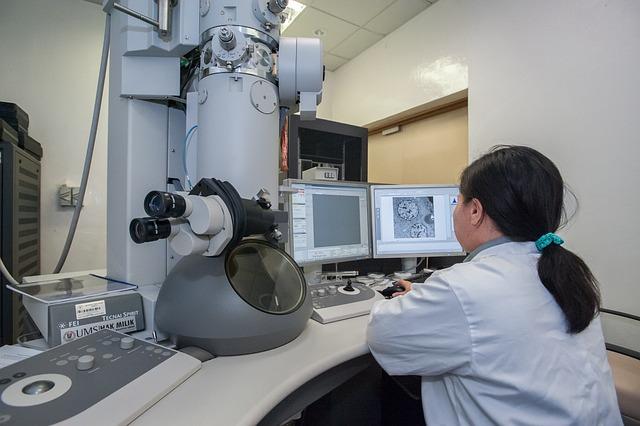| Complexity level: | 9 |
| Project cost ($): | 300 |
| Time required: | 2 days for preparation, 6 days to conduct the science experiment |
| Material availability: | Access to suitable laboratories with the appropriate equipment is required |
| Safety concerns: | Proper supervision by a qualified laboratory technician is required. |
Hypothesis
The formation of gallium oxide nanowires will occur at temperatures above 900 °C.
Overview
Gallium oxide nanowires
Nanowires are very small structures whose diameters are measured in nanometers (10 -9 meters). As their length is not constrained, the length to diameter ratio of these nanowires can be over 1000. Due to their tiny diameters, nanowires are considered one-dimensional.
The diameter of nanowires limits the number of electrons that can pass through at any one time. This is the result of electrons in nanowires being laterally quantum-confined and having energy levels that are different from the traditional energy band of bulk materials. This quantum confinement also results in certain nanowires having discrete values of electrical conductance.
Nanowires are now attracting a lot of interest from the scientific community, especially due to their potential applications in producing tiny components as well as circuits. Gallium oxide, a metal oxide semiconductor, has been successfully used to synthesize nanowires through chemical vapor disposition. The gallium oxide nanowires produced through this method have diameters ranging from 30 to 80 nanometers.
Scientific Terms
Materials
The materials required for this science fair project:
- 6 gallium beads, each measuring 1mm in diameter
- 1 aluminum tube furnace
- 1 cylinder of argon gas
- 6 pieces of silicon wafer
- Ni(NO3)2 solution (nickel nitrate solution)
- 1 beaker of water
- 1 ceramic plate
- 1 vacuum pump
- 1 electron microscope
Procedure
1. For this experiment, the independent variable is the temperature used for synthesizing the gallium nanowires. The dependent variable is the formation of the gallium nanowires on the substrate, which will be determined through observing the silicon wafers under an electron microscope. The constants (control variables) are the size of the wafers, the thickness of the Ni(NO3)2 substrate, the size of the gallium beads, the rate of increase in temperature and the level of pressure in the tube.
2. Coat a silicon waferwith Ni(NO3)2 solution and heat it to allow the water to evaporate. Repeat the process 2 more times. A thin coating of the substrate will then form on the surface of the silicon wafer. The film of substrate will act as the catalyst for the synthesis of gallium oxide nanowires.
3. Place the silicon wafer on a ceramic plate, with the gallium bead at the side. Place the plate inside the tube of the aluminum tube furnace. Then, position the beaker filled with water on the upstream end of the tube.
4. Fix the other end of the tube to a vacuum pump and remove all the air within. Fill the tube with argon gas.
5. While maintaining the argon gas flow at 90sccm and the pressure at 300 torr, increase the temperature of the furnace at a rate of 17 °C per minute. When the temperature of the furnace has reached 860 °C, maintain the new temperature for 20 minutes before reducing it to its original temperature, at the rate of 17 °C per minute.
6. Allow the silicon wafer to cool downand observed under an electron microscope to see if any gallium oxide nanowires have been successfully synthesized. Record the results , as shown below.
7. Repeat steps 2 to 6 at the higher temperatures of 880 °C, 900 °C, 920 °C, 940 °C and 960 °C. Record all results in a table, as shown below.
Results
The results show that gallium oxide nanowires only form at temperatures above 920 °C.
| Synthesis temperature | 860 °C | 880 °C | 900 °C | 920 °C | 940 °C | 960 °C |
| Nanowires forming | X | X | X | Y | Y | Y |
X – No nanowires synthesized, Y - Nanowires successfully synthesized
Conclusion
The hypothesis that the formation of gallium oxide nanowires will occur at temperatures above 900 °C has been proven to be incorrect. Gallium oxide nanowires will only form at temperatures of 920 °C and above.
Nanowires are currently still in the experimental stage in laboratories. They may be used alongside, or may even replace carbon nanotubes in certain applications. Plans are now in place regarding the use of nanowires in producing semiconductor devices, and in building the next generation of computers.
Also consider
This experiment may also be repeated by using zinc oxide to produce zinc oxide nanowires.
References
Synthesis of Gallium Oxide Nanostructures by Chemical Vapor Deposition - http://www.phy.ilstu.edu/~intreu/colinProj.htm
Nanowires - http://en.wikipedia.org/wiki/Nanowire
Controlled Structure of Gallium Oxide Nanowires - http://pubs.acs.org/doi/abs/10.1021/jp034728o

